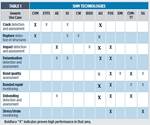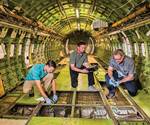Structural health monitoring: Decades of demos build confidence
Current momentum in local structural health monitoring development can be credited to a great deal of developmental effort on the part of these system developers.
Current momentum in local structural health monitoring (SHM) development can be credited, in part, to developmental effort on the part of the system developers that follow.
CVM system demonstrations in both metal and composites applications by Structural Monitoring Systems (SMS, Nedlands, Australia; Century City, CA, US and Ashford, UK) include installations flying on military fixed-wing aircraft and rotorcraft as well as commercial airliners in service, most notably for Delta Air Lines (see main article). The last readings from those systems — mounted to metal structures — were taken a couple of years ago, making that nearly a decade of in-flight service, and that data was subsequently shared with the US Federal Aviation Admin. (FAA, Washington, DC, US).
Brazilian aircraft manufacturer Embraer (Embraer-Empresa Brasileira de Aeronautica S.A., São José dos Campos) also has E-190 regional jet aircraft fitted with CVM and SMART Layer systems flying for several commercial airline customers, as it prepares to introduce a scheduled structural health monitoring (S-SHM) system that involves the installation of fatigue and corrosion sensors in hard-to-access areas of the aluminum airframe around the aft doors.
Meanwhile, Acellent Technologies (Sunnyvale, CA, US), the US Army Research Laboratory (ARL, Adelphi, MD) and the Aero-Flight Dynamics Directorate (AFDD, Moffett Field, CA, US) have been flight-testing Acellent’s SMART Layers on H-60 Blackhawk helicopter metal structures for 5 years to validate their integration and long-term operation and survivability on rotorcraft. Acellent also has completed Small Business Innovation Research (SBIR) projects with the US Navy for SHM systems on composites, which are supported by H-60 manufacturer, Sikorsky (Stratford, CT, US), for future implementation on the more composites-intensive CH-53K.
Other large-scale tests include those completed by the Tokyo, Japan-based “heavies” — Fuji Heavy Industries, Kawasaki Heavy Industries and Mitsubishi Heavy Industries — as part of the Japanese SHM Technologies for Aircraft Composite (JASTAC) structures program. In 2013, Airbus (Toulouse, France) extended this program to a second phase — which also includes the Japanese Aerospace Exploration Agency (JAXA, Tokyo) — targeted to deploy Phase I optical fiber-based SHM technologies into aircraft, extending through what Airbus terms Generation 3 in its SHM Roadmap (see the Roadmap in chart form, at left).
This short article is a sidebar to a feature story titled "Structural health monitoring: NDT-integrated aerostructures enter service," for which there is also a companion sidebar, titled "Structural health monitoring: The toolbox." To read either story, click on its title under "Editor's Picks," at top right.
Related Content
-
Xnovo Technology, Exciscope introduce X-ray tensor tomography technique
Through a strategic partnership, the companies introduce the FiberScanner3D module, dedicated to bringing more rapid, reliable and robust fiber structure characterization methods to lab settings.
-
Photothermal tomography for locating, quantifying defects in composites
Years of infrared testing development result in thermography technology that is no longer just qualitative, but can define defect size and depth, making additional UT scans obsolete.
-
Carbon fiber/flax landing gear achieves 54% weight reduction via tailored layup optimization
Fuko’s Biogear showcases how strategic composite material distribution and natural fiber damping properties can lightweight and enhance critical aerospace structure performance.






